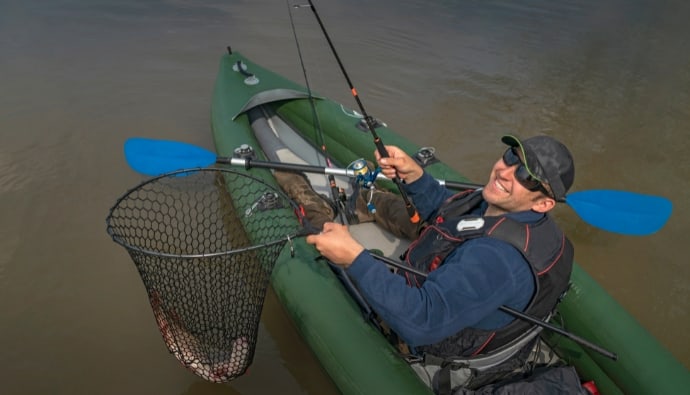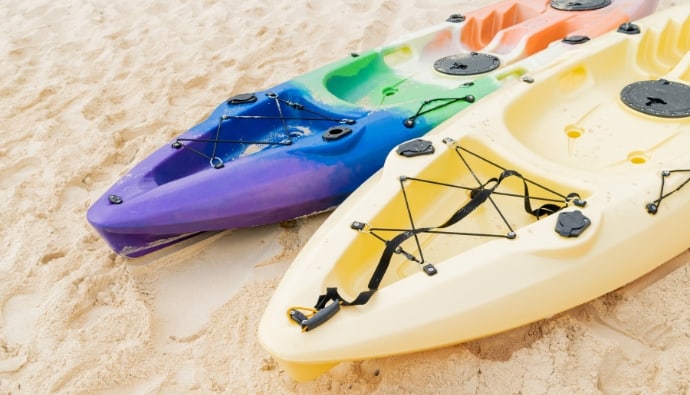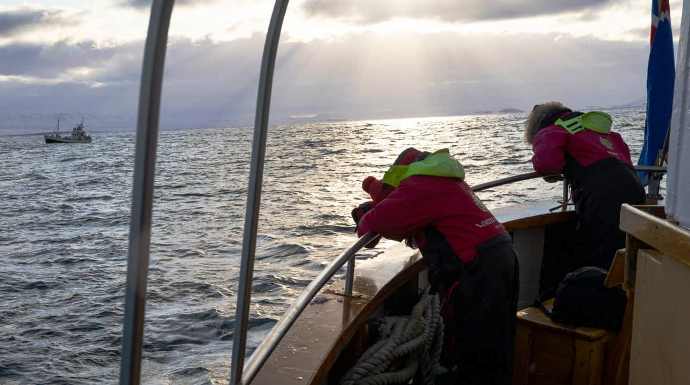Dressing for your angling adventures is crucial for both comfort and safety on the water. Choose quick-drying, moisture-wicking materials like synthetic or merino wool. This will keep you dry and comfortable in varying weather conditions. A lightweight, long-sleeved top and shorts or pants are perfect. These offer protection from the sun and shield you from the elements. At the same time, it allows for unrestricted casting and paddling. Remember to wear a hat and polarized sunglasses. This reduces glare and improves your ability to spot fish beneath the water’s surface. Opt for water shoes or sandals with a secure grip for stability on slippery surfaces. Pack a waterproof, breathable paddling jacket and a change of clothes in a dry bag. And finally, always wear a personal flotation device (PFD) for your safety.
Planning your next kayaking adventure? Prepare with appropriate attire to ensure a safe and enjoyable experience. Understanding what to wear can make all the difference in comfort and performance.
In this guide, we’ll discuss what to wear depending on different environments. From clothes to the latest kayak gear, we’ll help you out. Let’s dive in and explore what to wear for kayaking.

Factors to Consider When Choosing Kayaking Attire
Weather Conditions
When fishing in a kayak, it’s important to dress for the weather. This will ensure your comfort and safety, whatever the water temperature.
Make sure to consider both the air and water temperatures. Dress for kayaking with these in mind. Below, we discuss how to dress for any air temperature and water temperatures.
What to Wear Kayaking in Warm Weather (Warm Water Temperature)
Choose the right Fabrics to Wear in Warm Weather
Choose clothing made from lightweight and breathable materials during warm weather. This is especially true with the hot air temperature. Synthetic fabrics like polyester or nylon are ideal for warmer weather. These fabrics wick moisture away from your skin and dry fast. Avoid cotton, as it absorbs water and takes longer to dry, which can cause discomfort.
Consider sun exposure
Sun protection is essential in warm weather. Look for UPF-rated clothing, which provides added sun protection from harmful UV rays. Long-sleeve shirts and pants can help shield your skin from the sun. A wide-brimmed hat will protect your face and neck.
Polarized sunglasses also help protect your eyes from the sun. Don’t forget to use water-resistant, high-SPF sunscreen.
Use proper footwear
Kayak shoes or sandals with good traction are ideal for warm water temperatures. If you prefer more protection for your feet in salt water, consider closed-toe options.
What to Wear Kayaking in Cold Weather (Cold Water Temperature)
Choose the right materials
When cold weather paddling, wear layers to regulate your body temperature. Keep yourself warm. Start with a base layer made of moisture-wicking materials. This can be polyester or merino wool.
Add an insulating outer layer too. Fleece or synthetic insulating materials provide warmth in colder weather.
Finally, use outer layers that are waterproof and breathable. This will protect you from the elements.
Wear a dry suit
Unless you plan to paddle in protected waters, we recommend wearing a dry suit for all conditions. To stay warm and dry, a dry suit should fit and seal up all entry points (such as the neckline and wrist cuffs). Most of all, make sure to wear appropriate insulation underneath your dry suit.
A dry suit will keep water out, so you don’t have to worry if you fall out of the kayak and into the cold water.
Use proper footwear
Proper water shoes are essential if you’re planning on kayaking in particularly cold conditions. Choose neoprene booties or waterproof boots paired with wool socks. Make sure your footwear fits with your kayak’s pedals or foot braces.
Type of Kayaking
Different kayaking activities may require specialized clothing or gear. For recreational kayaking, comfort and sun protection are key. Touring kayaking, which involves longer distances and changing conditions, calls for versatile clothing such as a spray skirt. Whitewater kayaking demands additional safety gear like a helmet and personal flotation device (PFD).
Understanding these factors will help you choose the right attire for any kayaking adventure.
By selecting appropriate clothing and gear, you can stay comfortable, safe, and ready to make the most of your time on the water.
Essential Clothing and Gear for Kayaking
Base Layer
When kayaking, the base layer is crucial.
It should be made from moisture-wicking, quick-drying materials such as synthetic materials, merino wool, or silk.
Synthetic materials are lightweight and have quick-drying properties. On the other hand, merino wool offers excellent temperature regulation and odor resistance. It also has moisture-wicking capabilities. Lastly, silk is great if you want a lightweight and breathable fabric.
Choose the right base layer to ensure a comfortable kayaking experience.
Insulation Layer
Cold weather kayaking calls for extra warmth.
An insulation layer is essential, as it traps heat close to your body and keeps you cozy. Fleece and wool materials are ideal choices, offering excellent thermal properties and maintaining body heat even when wet.
Fleece is popular among kayakers.
It’s lightweight, breathable, and dries quickly. Opt for fleece jackets or pullovers designed for outdoor activities, as they have added features like zippered pockets and reinforced panels for durability.
Wool is a natural insulator.
Merino wool, in particular, is a great option. It’s softer and less itchy compared to traditional wool, boasting moisture-wicking and odor-resistant properties that are beneficial during prolonged kayaking trips.
Choose the right fit.
Your insulation layer should fit comfortably over your base layer without restricting movement, ensuring efficient paddling and warmth throughout your adventure.
Outer Layer
Quality is key in outerwear.
Look for jackets and pants made from materials like Gore-Tex, eVent, or other proprietary waterproof and breathable fabrics. These materials allow perspiration to escape while preventing water from seeping in, ensuring you stay dry even during wet or splashy conditions.
Consider essential features.
Choose outerwear with useful features such as adjustable hoods, cuffs, and waistbands. These adjustments help keep water out and allow you to customize the fit. Zippered pockets, underarm vents, and reinforced areas are also valuable additions that enhance comfort and durability.
Layering for success.
Your outer layer should fit comfortably over your base and insulation layers without restricting movement. A well-fitted outer layer not only provides protection from the elements but also contributes to an enjoyable and efficient kayaking experience.
Personal Flotation Device (PFD)
Wear a personal flotation device (PFD) as a critical safety measure while fishing in a kayak. If you’re thinking of what to wear kayaking, a PFD is crucial. Aside from keeping you afloat, they also serve as protection in case of an emergency or capsizing.
Below, we’re sharing the different types of PFDs.
Types of PFDs for Kayaking
When choosing a PFD for kayaking, understand the differences between the available types. The two most used PFDs for kayaking in the summer are Type III and Type V.
- Type III PFDs are ideal for kayaking. They balance buoyancy and freedom of movement. These life vests are comfortable to wear for extended periods.
- Type V PFD is a specialized life jacket. It’s specifically designed for outdoor activities like sea kayaking. They often include extra features like pockets and attachment points for essential gear.
Features to Consider
When selecting a PFD for kayaking, keep the following features in mind:
- Proper fit and adjustability
- Ensure that your PFD fits without being too tight or restrictive. Look for adjustable straps and buckles that allow you to customize the fit.
- Pockets and attachment points
- Having pockets and attachment points on your PFD can be beneficial. You can store essential items, such as a whistle, knife, or small fishing gear, within easy reach.
- High-visibility colors
- Opt for PFDs in bright, high-visibility colors like neon yellow, orange, or green. These colors make it easier for other boaters to spot you on the water.
Protective Gear
Proper protective gear is essential for a safe and enjoyable kayak fishing experience. Select the right helmet, gloves, and spray skirt.
Helmet
A helmet is an important piece of protective gear for kayak fishermen. Make sure to pick one that fits on your head and provides ample coverage.
A helmet is especially important if you’re planning on whitewater kayaking. It will protect your head in case you fall.
When choosing one, consider the size and fit. It should be snug but not overly tight. Check if it has ventilation. This will keep you cool when it’s hot out.
Paddling Gloves
Gloves can help protect your hands from any cuts, scrapes, and blisters.
Wear a paddling glove especially if you want to kayak longer. This will help you avoid blisters or calluses and provide enough grip. Look for gloves with extra padding in the palm to absorb shock and lessen fatigue.
Here are four main types of gloves to consider:
- Fingerless gloves offer excellent dexterity and grip. It’s ideal for fishing tasks and warmer air temperatures.
- Full-finger gloves focus on protection and warmth. It’s perfect when you’re planning on kayaking in the cold weather.
- Neoprene gloves are well-insulated and water-resistant making them the perfect choice for cold water and wet conditions.
- Finally, paddling-specific gloves are specially made for kayakers. It provides enhanced grip and padding so you can enjoy kayaking a bit longer.
Extra Accessories on What to Wear Kayaking
Dry bag
Keep your important things dry and safe with a dry bag. This is where you can put your electronics and other stuff that you don’t want to get wet.
Dry bags come in various sizes and are often made from materials like PVC or nylon.
Look for one that has attachment points so you can secure it to your kayak.
Towel or changing robe
Always bring a quick-drying microfiber towel. This will help you stay warm in case you get wet.
A changing robe is also great if you want to change out of your wet clothes in a public setting or limited space.
Hydration system
Staying hydrated is crucial during any outdoor activity. Opt for water bottles with secure attachment points so you can fasten them to your kayak. This prevents them from getting lost or damaged.
Or, consider hydration packs designed for kayaking. These have a hands-free and ergonomic design so that you can paddle to your heart’s content.
Final Thoughts on What to Wear Kayaking
When it comes to kayaking, choose what to wear depending on the weather. Wear a personal flotation device, and have the necessary protective gear.
Consider buying extra accessories. This can be dry bags, towels or changing robes, and hydration packs.
Personal comfort and safety are important when kayaking. We hope our recommendations above can help you prepare for your kayaking adventures.
All in all, it’s important to adapt your attire and gear to your individual needs and preferences. Everyone’s comfort levels and requirements may vary. Take the time to experiment with different items to find the combination that works.





 Facebook
Facebook YouTube
YouTube








